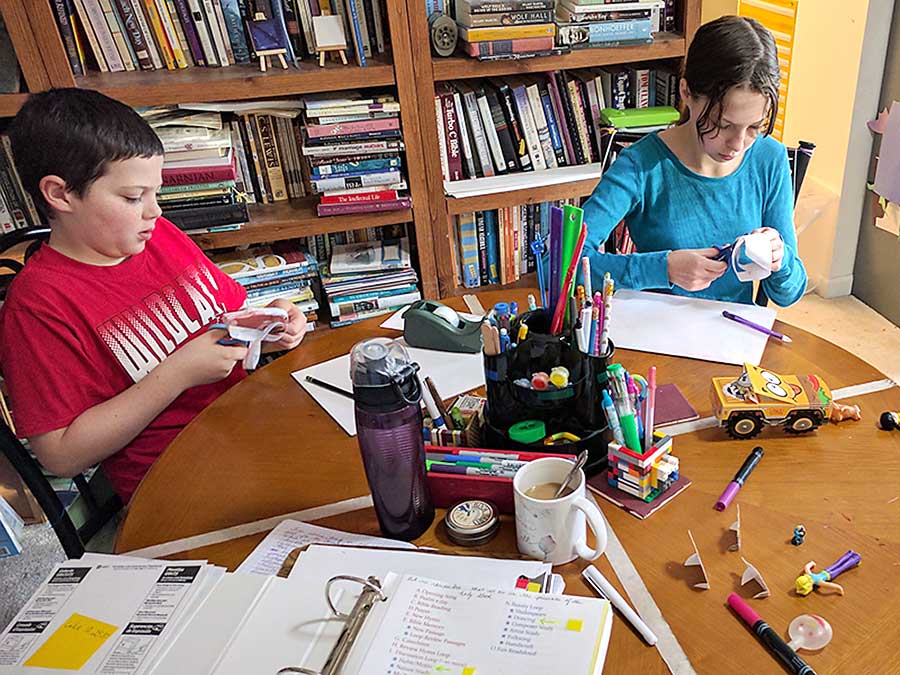
I was recently asked, “How can I possibly fit Morning Time into my jam-packed day? It takes us all day to just do the basics with my kids. We don’t have time to add anything else.”
That could absolutely be true.
However, I’ve found that work, like slime, expands to fit the time available. So if you have a wide swath of hours to fill and no reason for urgency and all the seeming drudgery of the basics, it will fill those hours.
In my experience – and I realize this is anecdotal – the days we do Morning Time are the days our other studies go better.
I think it’s a combination of two things: 1) our minds are open on truth, goodness, and beauty and, thus, are able to attend to the other lessons with greater capacity and 2) there’s an urgency that spending time doing these things creates that artificial limits do not.
Time spent on Morning Time creates a sense of urgency
Have you ever noticed that the more you have to get done, the more you get done? In my experience, when there is no sense of the urgent, I (and my children) are more lackadaisical about getting the work done.
However, when we have a particularly busy week with sports and music and social engagements, the work is magically done more quickly and efficiently.
And with less grumbling.
When there’s more to do, I get more done more easily. When there’s more to do, I work more steadily. When there’s more, to do I daydream less; I waste less time. When there’s more to do, I’m more focused.
I can’t believe I’m the only one.
Morning Time can do two things for you here. By combining easy-to-skip subjects together, Morning Time can give weight to those topics and ideas you really want to enjoy with your children and give them the weight to get done. It allows you to pull group learning together in a concerted effort – whether that group be 10 children and mom or one child and mom.
All are gathered, learning together. It’s efficient learning at its best!
But, second, it can be the opening bracket to your day. It can say “this is our start, these are the most important things on the list, these are priorities.” As a foundation to the day, Morning Time gives firm footing to dig into the “basics.”
If you have a natural limit to the end of the day – nap time, leaving for extra-curriculars, a promised play-date with a friend, unstructured free time (admittedly, this last doesn’t seem to be an impetus for my kids, but I hear it is for others) – you may be surprised at the power to accomplish the other work being sped up.
So, by limiting the amount of time available to fill with “the basics” you may find that you need less time for them than you thought.
The Transcendentals are both inspirational and aspirational
Here at Your Morning Basket, we talk a lot about “the transcendentals” – Truth, Goodness, and Beauty – when it comes to Morning Time. There’s a reason for that! Truth, Goodness, and Beauty align our thinking, actions, and heart. They provide ordo amoris – the ordering of our affections or loves.
When we know what is lovely, when we love what is lovely, when we have a sense of why it is lovely, we become more interested in creating loveliness ourselves. We can find what is lovely in what might otherwise seem tedious and uninspired.
The Merriam-Webster dictionary defines inspire “to exert an animating, enlivening, or exalting influence on.” The transcendentals give us something to work out, to become, to be like. They infuse us with a sustaining interest.
Similarly, Merriam-Webster defines aspire as “to seek to attain or accomplish a particular goal.” To aspire is to participate in creating truth, goodness, and beauty – there’s an output, an end that we can have in mind.
By taking inspiration from Truth, Goodness, and Beauty we aspire to produce it in our lives.
This combination of inspiration and aspiration can flow over into and bring energy to math, reading, and writing. It can animate a need to understand the Golden Ratio and create a beautiful painting; to use words splendidly to write a poem or essay; to see the wit and humor in Pride and Prejudice and the bravery in Saint George and the Dragon and to become like that.
Morning Time work opens our minds, eyes, and hearts to see and love what could be tedious. It can energize us for the tasks at hand – which in turn can make accomplishing the other work less of a struggle.
I was googling around for something, and one of the articles I read said that the first step to getting things done was “starting with a full tank.” I like that. Morning Time filled with Truth, Goodness, and Beauty gives you a full tank to fuel all the other things.
There are many important lessons learned in Morning Time
But, it’s more than fuel, aspiration, and inspiration. Spending time in Morning Time working through ideas back to back to back, helps us learn how to focus attention and work to completion. These skills of attention and diligence are exactly the skills our children need to develop to persevere through the work of the rest of the day.
It sets them up to hear and understand the math concept. It helps them to attend to the story being read. It strengthens them to persevere even when their hand feels as though it might fall off from copywork.
The direct lesson is not the only lesson we learn, the how-to-learn lesson by regular repetition is part of it as well. The attitudes, the habits of learning are a lesson we all want to build.
Morning Time is about relationships
Morning Time is an opportunity to make all kinds of relationships. The first is a relationship with your kids. Would you rather laugh over a MadLib or fight through a grammar worksheet?
As a family team you all learn a funny poem together to share with daddy, then have that inside joke as a part of your family culture. Frankly, me singing a hymn or folksong by myself doesn’t compare with all four of us (plus the dog) singing together.
It’s also about relationships with ideas. The True, Good, and Beautiful give more ideas for you and your students to form relationships with. This “Science of Relations,” as Charlotte Mason calls it, defines learning. As we create relationships with ideas, we begin to see how seemingly disparate ideas cross and connect.
When we have relationships with ideas and things, we build a web of ideas that catches more ideas and strengthens the strands between them and us. Morning Time builds anchors and connections; the central hub of the web; and the moorings and framework onto which we can build more and more.
“How do you fit it in with everything else?” is perhaps not the right question
We have days when we skip Morning Time for one reason or another. Often it’s because I forget all its benefits. Or am lazy – “just do your independent work.” Or am so focused on all the things – “we’re so ‘behind.’” Those are the worst days of our homeschool.
When our hearts are oriented toward the right things, the rest falls into place. We can learn other things. We have a framework on which to utilize the “basics.” We have limits on our time that propel us forward. My question becomes “Why wouldn’t you fit it in with everything else?”
- How to be more flexible with your homeschooling - February 21, 2024
- Help! If I’m up, the kids are up! - January 18, 2021
- The Habit That Changed My Life - January 12, 2021



